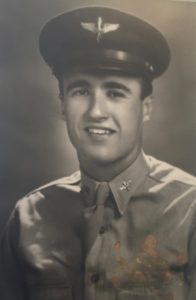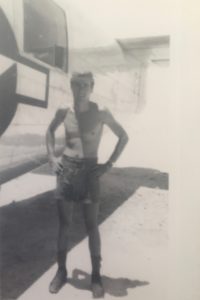The Typhoon Hunters
Use controls above or click here to open this Hometown Heroes podcast in a new window
93-year-old Richard Cruise of Bakersfield, CA appears on episode #530 of Hometown Heroes, airing June 28-July 1, 2018. A native of East Lansing, MI, Cruise served as a B-24 navigator with the 55th Reconnaissance Squadron, Long Range, Weather in the Pacific during World War II.
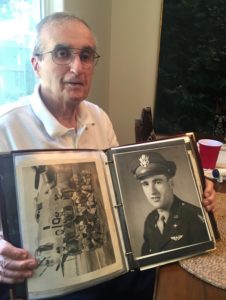
Richard Cruise at 92… and 20. For more photos, visit the Hometown Heroes facebook page.
You’ll hear him recall sneaking into Michigan State Spartan sporting events as a kid in East Lansing, and you’ll hear his spot on recollection of the Detroit Tigers’ starting lineup, as he heard it described regularly on the radio by Harry Heilmann, a Hall of Fame player-turned-announcer who had served in the Navy in World War I.
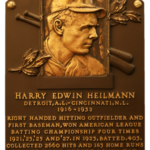
Harry Heilmann’s plaque at the Baseball Hall of Fame. Listen to Hometown Heroes for Richard Cruise’s memories of Heilmann’s unique announcing style.
As in so many American homes in the 1940s, radio was the Cruises’ quickest connection to current events around the world, especially on December 7, 1941.
“I had just finished mopping my mother’s kitchen floor,” Richard remembers. “The swinging door slowly came open. My dad was there. He said, ‘The Japanese have attacked Pearl Harbor.'”
The shocking news gradually set in as he remained glued to the radio for updates over the days that followed. Staying up to date on the progress of the war over the next year, he noticed that some of his classmates were starting to enlist in the military in early 1943, and decided he should do the same. You’ll hear what led to his joining the Army Air Corps as opposed to his initial thought of naval aviation, and how his aim at becoming a pilot was rerouted toward navigation.
After initial training in Wichita Falls, TX, he started operating as a navigator on a B-24 training crew out of Tucson, AZ. “We camera bombed virtually every small town in southern New Mexico and parts of Arizona,” he quips. Those two months of transition training also afforded him an opportunity very few have ever experienced: flying in a B-24 not just over the Grand Canyon, but inside of it, thanks to his pilot’s whim.
“I’m in the nose of the airplane looking out the right hand side, headed west,” he remembers. “That’s when I realized I was looking up at the north rim.”
Richard would get to know that 10-man crew very well as they deployed to Guam with the 55th Reconnaissance Squadron. The B-24Ls they flew there were modified to reflect the weather-related assignment. Instead of explosives, the forward bomb bay contained a pair of 250-gallon fuel tanks. Where the rear bomb bay would typically be, the doors were welded shut, with an airborne radar unit occupying the carpeted space above. As the navigator, Cruise was positioned in the nose of the airplane, right next to the meteorologist.
“We claimed we were the only two guys on the airplane that were working,” you’ll hear him say of their pattern of reports every 20 minutes. “Or even awake sometimes.” They would pass on relevant info to the pilots, who would then relay it to the radioman for transmission back to 20th Air Force headquarters.
“Our real job was to find typhoons as they developed,” he explains. “and be able to track them from there, just so people could get out of the way.”
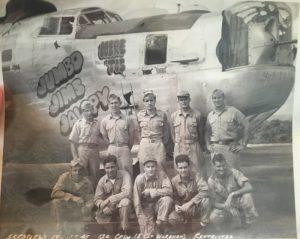
Richard Cruise, standing middle, with the rest of his crew on Jumbo Jim’s Jalopy, named for pilot Jim Worsham.
Flying off of Guam for solo patrols that would last up to 16 hours, sometimes over enemy territory, the weather crew knew several potential hazards could be looming. Engine failure was a major concern, given the solitary nature of their missions, and Cruise carried a pistol in case they had to go down in Japanese-held waters. They had instructions on keeping their distance from specific enemy strongholds like Truk and Yap, and of course, they knew that the very weather formations they were investigating could prove deadly. You’ll hear Cruise relate his memories from the incident that proved most harrowing for him, on a day in which their radar unit was inoperable and could not warn them of the weather system’s intensity. They had been instructed to drop down to 500 feet elevation if they ever got caught in a storm of that magnitude.
“It was the ugliest ocean I’ve ever seen in my life,” he says of the tempestuous scene. “Suddenly this airplane got thrown up, probably the better part of two thousand feet, in a matter of seconds.”
The pilot and co-pilot pulled the aircraft out of the ensuing stall, wrestling control and guiding it through the storm. Listen to Hometown Heroes for more specifics on how a 20-year-old Richard Cruise experienced those tense and turbulent moments. It wasn’t until debriefings gave him a closer look at perspective from the rest of the crew that Cruise fully understood how close they had all come to a tragic conclusion.
“We flew right through the ring, probably the most violent part of it,” you’ll hear him reflect. “We were lucky to survive it, and I think about it frequently.”
Listen to Cruise’s interviews for additional close calls he endured, and the more complete picture of his squadron’s significance that he has filled in over the years, through attending reunions and studying documentation. After his discharge, he attended the University of Michigan, transferring to UCLA after experiencing California sunshine on a trip to the 1948 Rose Bowl. He has been in the Golden State ever since. After a long career in broadcast sales, he spent 19 years as a volunteer docent at the Palm Springs Air Museum.
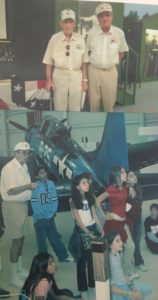
Richard helped tell WWII and aviation stories for 19 years as a docent at the Palm Springs Air Museum.
“I learned a great deal there from the people I was serving with,” he says of his time at the museum. “Probably more importantly, people coming in, many of whom had their own stories, and shared them with you. I value all of that.”
We value Richard Cruise’s service to our country, and thank his son Chip and loyal listener Mark Thurston for connecting us to this proud veteran and his unique story. Watch the video below for Mr. Cruise’s explanation of the 55th Reconnaissance Squadron’s mascot, Willie Weatherbee.
—Paul Loeffler

